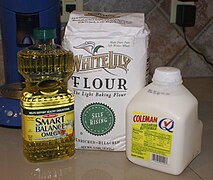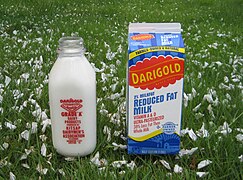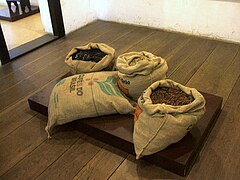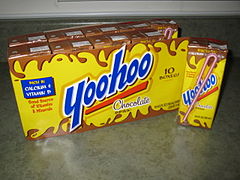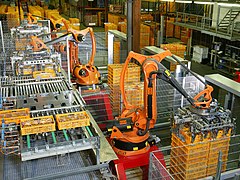Food packaging

Food packaging is a
History
Packaging of food products has seen a vast transformation in technology usage and application from the Stone Age to the industrial revolution:
7000 BC: The adoption of pottery and glass which saw industrialization around 1500 BC.[3]
1700s: The first manufacturing production of tinplate was introduced in England (1699) and in France (1720). Afterwards, the Dutch navy start to use such packaging to prolong the preservation of food products.[4]
1804: Nicolas Appert, in response to inquiries into extending the shelf life of food for the French Army, employed glass bottles along with thermal food treatment. Glass has been replaced by metal cans in this application.[5] However, there is still an ongoing debate about who first introduced the use of tinplates as food packaging.[4]
1870: The use of paper board was launched and corrugated materials patented.[6]
1880s: First cereal packaged in a folding box by Quaker Oats.[7]
1890s: The crown cap for glass bottles was patented by William Painter.[8]
1950s: The bag-in-box system was invented by American chemist William R. Scholle – initially for acid liquids, but quickly also used for food liquids.
1960s: Development of the two-piece drawn and wall-ironed[further explanation needed] metal cans in the US, along with the ring-pull opener and the Tetra Brik Aseptic carton package.[9]
1970s: The barcode system was introduced in the retail and manufacturing industry. PET plastic blow-mold bottle technology, which is widely used in the beverage industry, was introduced.[10]
1990s: The application of digital printing on food packages became widely adopted.
Plastic packaging saw its inaugural use during World War II, even though materials employed in its manufacturing (such as cellulose nitrate, styrene and vinyl chloride) were discovered in the 1800s.[11]
Functions
Packaging and package's labeling have several objectives:[12][13]
- Physical protection - The food enclosed in the package may require protection from shock, vibration, compression, temperature, bacteria, etc.
- Barrier protection - A barrier from oxygen absorbers, or ethyleneabsorbers to help extend shelf life.
- Containment or agglomeration - Small items are typically grouped together in one package to allow efficient handling. Liquids, powders, and granular materials need containment.
- Information transmission - Packages and labels communicate how to use, transport, recycle, or dispose of the package or product. Some types of information are required by governments.
- Marketing - The packaging and labels can be used by marketers to encourage potential buyers to purchase the product. Aesthetically pleasing and eye-appealing food presentations can encourage people to consider the contents. Package design has been an important and constantly evolving phenomenon for several decades. Marketing communications and graphic design are applied to the surface of the package and (in many cases) also to the point of sale display. The colour of the package plays a significant role in evoking emotions that persuade the consumer to make the purchase.[14]
- Security - Packaging can play an important role in reducing the tamper-evident features to help indicate tampering. Packages can be engineered to help reduce the risks of package pilferage; some package constructions are more resistant to pilferage and some have pilfer-indicating seals. Packages may include authentication seals to help indicate that the package and contents are not counterfeit. Packages also can include anti-theft devices, such as dye packs, RFID tags, or electronic article surveillance tags, that can be activated or detected by devices at exit points and require specialized tools to deactivate. Using packaging in this way is a means of retail loss prevention.
- Convenience - Packages can have features which add convenience in distribution, handling, stacking, display, sale, opening, reclosing, use, and reuse.
- Portion control - Single-serving packaging has a precise amount of contents to control usage. Bulk commodities (such as salt) can be divided into packages that are a more suitable size for individual households. It also aids the control of inventory: selling sealed one-liter bottles of milk, rather than having people bring their own bottles to fill themselves.
Types
Packaging design may vary largely depending on the function that are fashioned into different types of packages and containers, and depending on the food products and their function, such as:[15]
| Packaging | Type | Foods | Materials |
|---|---|---|---|
| Aseptic packaging | Primary | Liquid whole eggs or dairy products
|
Polymers, multi-layer packaging |
Trays
|
Primary | Portion of fish, meat, fruits, vegetable, sweets and convenience foods | Polymers, cardboards, biopolymers |
| Bags | Primary | Potato chips, apples, dried fruits, rice, snacks | Metallized polymers, polymers, multi-layer packaging
|
Cans
|
Primary | Can of tomato soup, beans, mais, salmon, tuna, and prawns | Aluminum, tin, stainless-steel |
| Cartons | Primary | Carton of eggs , milk, and fruit juice
|
Multi-layer packaging, coated paper |
Flexible packaging
|
Primary | Bagged salad, potato chips, sweets and candies | Polymer, biopolymer |
| Boxes | Secondary | box of cereal cartons, frozen pizzas | Cardboards |
| Pallets | Tertiary | A series of boxes on a single pallet used to transport from the manufacturing plant to a distribution center | wooden pallet
|
Wrappers
|
Tertiary | Used to wrap the boxes on the pallet for transport | Polymer, multi-layer packaging |
Since almost all food products is packed in some fashion, food packaging is both fundamental and pervasive.[16] Additionally, by enabling the creation and standardization of brands, it provides the opportunity to realized significant advertising, extensive distribution, and mass merchandising.[16] Therefore, a distinction between the various type (or level) of packaging needs to be made.
Primary packaging
Primary packaging is directly in contact with the food products, creating the ideal headspace for them while providing protection from external alteration. Additionally, primary packaging, also known as retail packaging or consumer units, is responsible for the marketing aspects of food packaging.[4] Typically, the packaging materials used in the primary level include cardboard cartons, plastic trays, glass bottle and multi-layerd structure (Tetra Pak).
Secondary packaging
Secondary packaging contains a number of primary packages into one box being made usually out of corrugated cardboard. Thus, the secondary level is a physical distribution carrier for the primary packages, making more easy to handle during the transportation. Occasionally it can be used as an aid in retail outlets or super market for the display of basic goods.[4]
Tertiary packaging
The outermost package, known as tertiary packaging, makes it easier to handle, store, and distribute both primary and secondary packages in bulk safely, providing further protection of the product while creating an easy way to transport large quantities of materials. The most familiar type of tertiary packaging comprises a wrapped pallet of corrugated case.[17]
Gallery
-
Bagged cake mix
-
Biscuit components: plastic bottles, paper bag
-
Container for bulk vegetable oil
-
Frozen processed food freezer in supermarket
-
Bag in box; box wine
-
Glass milk bottle and paperboard milk carton
-
Silk tea bag
-
Coffee beans in burlap bags, gunny sacks
-
Bushel baskets of fruit
-
Tea tin, can with removable cover
-
Folding cartons of cereal
-
Drink boxes
-
Packaged apples
-
Fresh fish in plastic shrink-wrapped tray
-
Shrink-wrapped frozen pork
-
Condiments and spices
-
Aluminum can with an easy-open, full pull-out end
-
A Dip & Squeeze ketchup container
Packaging machines
A choice of packaging machinery requires consideration of technical capabilities, labor requirements, worker safety, maintainability, serviceability, reliability, ability to integrate into the packaging line, capital cost, floorspace, flexibility (change-over, materials, etc.), energy usage, quality of outgoing packages, qualifications (for food, pharmaceuticals, etc.), throughput, efficiency, productivity, and ergonomics, at a minimum.[18]
Packaging machines may be of the following general types:
- Autocoding label and date verification
- Blister, skin and vacuum packaging machines
- Capping, over-capping, lidding, closing, seaming and sealing machines
- Cartoning machines
- Case and tray forming, packing, unpacking, closing and sealing Machines
- Check weighing machines
- Cleaning, sterilizing, cooling and drying machines
- Conveying and accumulating machines
- Feeding, orienting, and placing machines
- Filling machines for liquid and powdered products
- Package filling and closing Machines
- Form, fill and seal machines
- Inspecting, detecting and checkweighing machines
- Palletizing, depalletizing, and pallet unitizing machines
- Labeling, marking, and other product identification machines
- Wrapping machines
- Converting machines
-
Automated palletizer of bread with industrial KUKA robots
-
Shrink-wrapping trays of bakery goods
-
Pumping slurry ice onto fresh fish
-
Filling machinery for bag-in-box
Reduction of food packaging
Reduced packaging and sustainable packaging are becoming more frequent, although excessive overpackaging is still common. The motivations can be government regulations, consumer pressure, retailer pressure, and cost control. Reduced packaging often saves packaging costs. In the UK, a
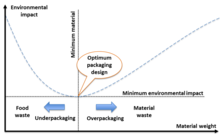
In the last decades, the growing demand from the consumers and governments for more sustainable and eco-friendly packaging design has driven the food industry to re-design and propose alternative packaging solutions.[20] However, in designing a brand new packaging system, several variables need to be taken in consideration. An ideal packaging design should only use the right amount of the appropriate materials to provide the desired performance for a specific product. As shown in the optimum packaging design chart, the variety of situations in which product losses occur increases as the material weight or volume is decreased.[21]
Such trend will eventually reach a situation in which the loss outweighs the cost savings from using less packing material. Beyond that point, any packing reduction increases the overall quantity of waste in the system, rendering it a false benefit. The goal of the optimal packaging design is to identify a weight below which the package can no longer be sold since it does not satisfy the specifications, while considering the environmental impact connected to the materials selection.[22]
End-of-use
- plastic waste, which can pollute the environment in a wide spectrum of scenarios. The packaging sector accounts for 40.5% of all plastic produced in Europe, which represents the largest sector in food industry.[23] However, the recycling of such wastege is at a critical low level of roughly 35%. Moreover, it has been estimated that over 20% of the plastic packaging does not reach any recycling process.[24]
- Bioplastic: also known as biodegradable polymer or biopolymer, are usually made from renewable feedstock resources like corn and sugar cane, as well as from microorganism of different kind. Typical end-of-life options include the composting or the environmental degradation of bioplastics, which result in resource loss and CO2 production. Complete degradation is also only achievable under rigorous conditions that are infrequently offered by the company. Additionally, some bioplastics are processed similarly to their traditional, fossil-based counterparts, which, if improperly sorted, might cause harmful interferences in other materials' recycling processes.[25]
- Paper and cardboard: are composed of cellulosic fibers bonded together to form a flexible structure. These packaging materials have a long tradition as the ideal solutions for storing dry foods (such as flour, rice, and pasta) as well as being used as secondary or tertiary packaging. Paper and cardboard are often collected separately for recycling; however, some difficulties are faced in the case of the presence of a coating (e.g., plastic or aluminum) or contamination due to food residues. Alternative end-of-life options include incineration and landfill. In theory, paper and board packaging is compostable, but persistent chemicals (like PFAS) may be dispersed in the environment through this practice, thus limiting the potential benefits.[26]
- Metal-based packaging can endure high temperatures and can provides outstanding gas, light, and aromas barriers, leading to a very competitive solutions in a broad range of application. Direct food preservation in the packaging was made possible with the development of the canning method.[27] Coatings, whether organic or inorganic, may lessen the interactions between metal and food. However, it was discovered that many of the chemicals in these coatings migrated into food. The end-of-life alternatives for metal food packaging differ depending on its usage: for example cans and lids can be broken down and recycled multiple times.[28]
- Glass: is an inorganic packaging that has been used for storing food and beverages. Nowadays, soda-lime glass is the commonly used variation manufactured from raw materials such as soda ash, limestone, and metal. Due to the structural characteristics of glass, the risk of migration into the food is very limited. Glass is incredibly chemically stable and durable when handled carefully (due to its fragile nature).[29] Therefore, this packaging material is an ideal candidate for repeated use, due to these characteristics. Glass can also be recycled multiple times without losing any quality properties.[30]
- Multi-layer packaging: in the food and beverage business, packaging composed of numerous layers of various materials is commonly referred to as multi-layer or multi-material packaging. In many countries, multi-material food packaging is frequently burned or disposed of landfills.[citation needed] Nevertheless, some areas are actively developing separate collections and efficient sorting processes for fiber-based multi-material packaging, such as beverage cartons. On the other hand, multi-layer packaging composed of aluminum and plastic barrier, cannot currently be recycled in an efficient way, and must undergo chemical treatment to be disposed of correctly. In light of these considerations, it is clear how, despite being the state-of-the-art in food packaging application, multi-layer packaging poses a great challenge when considering its end-of-life.[31] An exception is the case of multi-layer packaging consisting of several layers of the same material (or being part of the same category): such solutions in many cases allow for outstanding performance and, at the same time, allow for an easier recycling.[32]
Recycling of food packaging
Food packaging is created through the use of a wide variety of plastics and metals, papers, and glass materials. Recycling these products differs from the act of literally reusing them because the recycling process has its own algorithm which includes collecting, sourcing, processing, manufacturing and marketing these products. According to the Environmental Protection Agency of the United States, the recycling rate has been steadily on the rise, with data reporting that in 2005 40% of the food packaging and containers that were created were recycled.[citation needed]
The product's quality and safety are the package's most important responsibility. However, there have been growing demands for packaging to be designed, manufactured, consumed, and recycled in a more sustainable fashion due to the increasing pollution connected with packaging and
However, depending on the level of packaging and the materials that are being used during their manufacturing, the end-of-life of a package may differ completely. Despite the fact that a recycling process is usually the desired path, lots of complications may lead to less sustainable destines.[23]
Trends in food packaging
- Numerous reports made by industry associations agree that use of smart indicators will increase. There are a number of different indicators with different benefits for food producers, consumers and retailers.
- Temperature recorders are used to monitor products shipped in a cold chain and to help validate the cold chain. Digital temperature data loggers measure and record the temperature history of food shipments. They sometimes have temperatures displayed on the indicator or have other outputs (lights, etc.): the data from a shipment can be downloaded (cable, RFID, etc.) to a computer for further analysis. These help identify if there has been temperature abuse of products and can help determine the remaining shelf life.[33] They can also help determine the time of temperature extremes during shipment, so that corrective measures can be taken.
- Time temperature indicators integrate the time and temperature experienced by the indicator and adjacent foods. Some use chemical reactions that result in a color change, while others use the migration of a dye through a filter media. To the degree that these physical changes in the indicator match the degradation rate of the food, the indicator can help indicate probable food degradation.[34]
- Radio frequency identification is applied to food packages for supply chaincontrol. It has shown a significant benefit in allowing food producers and retailers to have full real time visibility of their supply chain.
- Plastic packaging being used is usually non-biodegradable due to possible interactions with the food. Also, biodegradable polymers often require special bioplastics, films and products are being developed.[35]
- There is an increasing development and production of food packaging materials containing substances and realizing systems intended to extend shelf life: carbon dioxide (CO2) emitters; antioxidants (e.g. butylated hydroxytoluene (BHT), butylated hydroxyanisole (BHA), tocopherols, hinokitiol); antimicrobial enzymes (e.g. lysozyme), polymers (e.g. ε-polylysine, chitosan) and nanoparticles (e.g. silver, copper, gold, platinum, titanium dioxide, zinc oxide, magnesium oxide, organically modified nanoclays); bacteriocins (e.g. nisin, natamycin); and essential oils.[36][37]
- In the last decades, the use of modified atmosphere packaging (MAP) and other variation of this technology has shown growing interest and application in the food packaging industry. The use of a specific gas mixture inside the packaging headspace has proven to be ideal to slow down the metabolic process of food product, thus prolonging the shelf-life of meat, fish, fruits and vegetables.[38]
- The design of multi-layer packaging system has been recognized as the state-of-the-art in food packaging application for its versatility, processability and efficacy. Each layer can be made of different materials and provides a key functionality for the whole structure, such as improved mechanical properties, chemical stability, barrier properties and anti-microbial properties. However, the use of such complex structure significantly reduces its recyclability (except for a few cases).[31]
- Recently, the application of protective coating on commercially available packaging materials (such as PET, PP, PLA cardboard or biopolymer) represents a potential solution to deal with the increasing environmental impact due to both food and packaging waste.[39]
- Barcodes have been used for decades in packaging many products. 2D barcodes used in autocoding are increasingly applied to food packaging to ensure that products are correctly packaged and date coded.
- The ability of a package to fully empty or dispense a viscous food is somewhat dependent on the superhydrophobic surfaces is useful but can be further improved by using new lubricant-impregnated surfaces.[40]
Food packaging barriers

A critical requirement in food packaging is represented by the barrier properties against the permeation of gases, water vapor, and aroma compounds of the packaging system. In fact, the chemical interactions between the products and the environment are the principal reasons for improper shelf-life and spoilage phenomena.[41] Therefore, the evaluation of the gas exchange by means of the permeation of gas molecules is a crucial aspect in designing a product.
The permeation of a gas molecule through a packaging system is a physical process made up of three independent phenomena: the adsorption of the molecule to the packaging's outer surface; the diffusion of the molecule through the packaging's section; and the desorption in the internal headspace.[42] Under the assumption of steady state condition, the physical processes involved in the permeation can be modeled by simple equations.[43] Particularly, the diffusion of a permeant's molecule is dependent to the concentration difference between the two sides of the packaging system, which acts as a driving force, thus creating a diffusive flux following the first Fick's law of diffusion.[4]
Furthermore, other assumptions are needed, such as the absence of chemical interaction between the penetrant and the packaging material and the fact that the diffusion flow must follow only one direction.[44] The adsorption/desorption processes of a permeant's molecule normally exhibit a linear dependency with the partial pressure gradient across the barrier layer while keeping the assumption of steady-state transport condition and exhibiting a concentration lower than the penetrant's maximum solubility, thereby adhering to Henry's law of solubility.[45]
The type of permeant, the barrier layer's thickness, the specific permeabilities of the packaging films against gases or vapors, the packaging's permeable area, the temperature, and the pressure or concentration gradient between the barrier's interior and external sides can all have an impact on a system's permeability.[46]
The gas exchange occurring between the packaging system and the external environment has a significant impact on the quality and safety of food products. Uncontrolled physico-chemical and biological processes such as oxidation of vitamins, excessive microbial growth, and spoilage of the packed food may lead to improper conditions inside the packaging headspace, hence reducing their shelf-life.[16] Therefore, the packaging system should be designed to create the ideal conditions for the selected product, avoiding excessive gas exchange.[42]
Among the permeants that could affect the organoleptic properties of food, oxygen and water vapor represent the most important ones. These permeants affect several bio-chemical processes in food products, such as ripening, degradation, hydration/dehydration, microbial growth, vitamins oxidation; they also have an impact on the organoleptic properties, hence causing off-flavours, excessive weight loss, textural changing and generally shortening the shelf life.[39]
To quantify the barrier properties of a packaging system, both oxygen and water vapor permeation are commonly assessed by measuring the
Oxygen barrier

The oxygen transmission rate of a gas through the packaging is defined as the amount of oxygen permeating per unit of permeable area and unit of time in a packaging system considering standardized test conditions (23 °C and 1 atm partial pressure difference). It is an effective tool to estimate the barrier properties of a certain material.[47] The determination of the OTR is usually carried out by means of a steady-state and isostatic method, reported by the ASTM D 3985 or ASTM F 1307, containing respectively standardized protocol for the measurements of the OTR of several kind of packaging.[43]
The typical instrumentation consists in a permeation cell composed by two distinct chambers separated by the tested material; one of the chambers is then filled with a carrier gas (e.g., nitrogen), while the other one with oxygen, hence creating the necessary driving force to let the oxygen permeate across the barrier's material.
Water vapor barrier

Concurrently to the oxygen barrier property, the permeability of water vapor through a food packaging system should be minimized to effectively prevent physical and chemical changes connected to an excessive moisture content.[46] The moisture barrier properties of a material can be assessed by measuring the water vapor transmission rate (WVTR), which can be defined as the amount of water vapor per unit of area and unit of time passing through the packaging film.[42]
The WVTR measurements, like the OTR, adhere to the standards for standardized tests as outlined in the ASTM E96 (standard methods for water vapor transmission of materials). An impermeable test dish (such as a stainless steel cup) and a test chamber where temperature and relative humidity (RH) can be adjusted in accordance with the standard specification, make up the basic instrumentation used in such tests.
Other vapors
Although both oxygen and water vapor represent the most studied permeants in food packaging application, other gases such as carbon dioxide (CO2) and nitrogen (N2) have also great relevance in the preservation of food products. In fact, N2 and CO2 have been employed in modified atmosphere packaging (MAP) technology to establish the correct conditions inside the package's headspace to lessen food spoiling.[48]
Food safety and public health
It is critical to maintain food safety during processing,
Health risks of materials and chemicals that are used in food packaging need to be carefully controlled.
Manufacturing
Packaging lines can have a variety of equipment types: integration of automated systems can be a challenge.
Product safety management is vital. A complete
See also
- Codex Alimentarius – Collection of internationally recognized standards
- Dietary supplement – Product providing additional nutrients
- Disposable product – Product designed to be discarded after use
- Edible packaging – Food containers which can be eaten
- Autocoding
- Food and Bioprocess Technology – journal
- Calabash – Species of bottle gourd plant
- Food fortification – Process of adding micronutrients to food products
- Food grading – Inspection and sorting of foodstuffs for various parameters
- Food preservation – Inhibition of microbial growth in food
- Food rheology – Study of the fluid mechanical properties of food
- Food safety – Scientific discipline
- List of food safety organisations
- Food storage – Type of storage that allows food to be eaten after time
- Food storage container – container for storing food
- Food waste– Food that is discarded, lost or uneaten
- Food waste in the United Kingdom – Overview of food wastage in the United Kingdom
- ISO 22000 – Food safety standard
- Nutraceutical – Marketing term for supplement
- Packaging waste – Post-use container and packing refuse
- Food labeling regulations
- United Kingdom food labeling regulations
- Packaging industry– Enclosure or protection of products for distribution, storage, and sale
- Washdown – Cleaning or washing a surface for appearance, sanitation, or removal of contamination
- WikiCell – edible food packaging
Notes and references
- ^ S2CID 12127364.
- hdl:11380/1163967.
- ^ "A Brief History of Packaging". ufdc.ufl.edu. Retrieved 22 May 2019.
- ^ )
- OCLC 41143092.
- S2CID 110373839.
- )
- )
- ISSN 0022-5142.
- ISSN 0022-5142.
- PMID 19719135.
- ^ Bix, L; Nora Rifon; Hugh Lockhart; Javier de la Fuente (2003). The Packaging Matrix: Linking Package Design Criteria to the Marketing Mix (PDF). IDS Packaging. Archived from the original (PDF) on 17 December 2008. Retrieved 11 December 2008.
- S2CID 12127364. Archived from the original(PDF) on 3 November 2021. Retrieved 21 September 2018.
- ^ "Importance of Product Packaging in Marketing".
- ^ Shaw, Randy (16 February 2013). "Food Packaging: 9 Types and Differences Explained". Assemblies Unlimited. Retrieved 19 June 2015.
- ^ )
- ISBN 978-981-10-3520-3.
- PMID 22659036.
- ^ "Farmer markets better at reducing waste".
- S2CID 216029128.
- ISBN 978-81-322-2228-6.
- .
- ^ S2CID 249363144.
- ^ S2CID 169735701.
- S2CID 237852939.
- .
- PMID 32549588.
- S2CID 219522693.
- S2CID 37567386.
- .
- ^ S2CID 246593505.
- S2CID 244187743.
- ^ Meyers, T (June 2007). "RFID Shelf-life Monitoring Helps Resolve Disputes". RFID Journal.
- S2CID 108566613.
- ^ EDIBLE COATINGS TO IMPROVE FOOD QUALITY AND FOOD SAFETY AND MINIMIZE PACKAGING COST, USDA, 2011, retrieved 18 March 2013
- PMID 33350066.
- ISBN 9780367397289.
- S2CID 36471832.
- ^ S2CID 214175106.
- hdl:1721.1/79068.
- PMID 33921733.
- ^ ISBN 9780128043028.
- ^ ISBN 9780123946010.
- PMID 33401814.
- Wikidata Q112841332.
- ^ .
- S2CID 137002813.
- S2CID 91640357.
- .
- ^ "Regulation of the U.S. Food Processing Sector". NDSU. Retrieved 19 June 2015.
- ^ Stephens, Pippa (19 February 2014). "Food packaging health risk 'unknown'". BBC News.
- PMID 22659036.
- PMID 27065919.
- ^ Hussain, Kazi Albab (2023). "Assessing the Release of Microplastics and Nanoplastics from Plastic Containers and Reusable Food Pouches: Implications for Human Health". Environmental Science and Technology. 57 (26). American Chemical Society: 9782–9792. Retrieved 1 February 2024.
- ^ Kajavi, M Z (2019). "Strategies for controlling release of plastic compounds into foodstuffs based on application of nanoparticles and its potential health issues". Trends in Food Science and Technology. 90. Retrieved 6 February 2024.
- S2CID 96099161.
Bibliography
- Hans-Jürgen Bässler und Frank Lehmann : Containment Technology: Progress in the Pharmaceutical and Food Processing Industry. Springer, Berlin 2013, ISBN 978-3642392917
- Heldman, D.R. ed (2003). "Encyclopedia of Agricultural, Food, and Biological Engineering". New York: Marcel Dekker
- Potter, N.N. and J.H. Hotchkiss. (1995). "Food Science", Fifth Edition.New York: Chapman & Hall. pp. 478–513.
- Robertson, G. L. (2013). "Food Packaging: Principles & Practice". CRC Press. ISBN 978-1-4398-6241-4
- Selke, S, (1994). "Packaging and the Environment". ISBN 1-56676-104-2
- Selke, S, (2004) "Plastics Packaging", ISBN 1-56990-372-7
- Soroka, W. (2009). "Fundamentals of Packaging Technology". Institute of Packaging Professionals. ISBN 1-930268-28-9
- Stillwell, E. J, (1991) "Packaging for the Environment", A. D. Little, 1991, ISBN 0-8144-5074-1
- Yam, K. L., "Encyclopedia of Packaging Technology", John Wiley & Sons, 2009, ISBN 978-0-470-08704-6
External links
- "Food Packaging -- Roles, Materials, and Environmental Issues - IFT.org". www.ift.org. Retrieved 3 December 2018.
- Poly(hydroxyalkanoates) for Food Packaging: Application and Attempts towards Implementation


